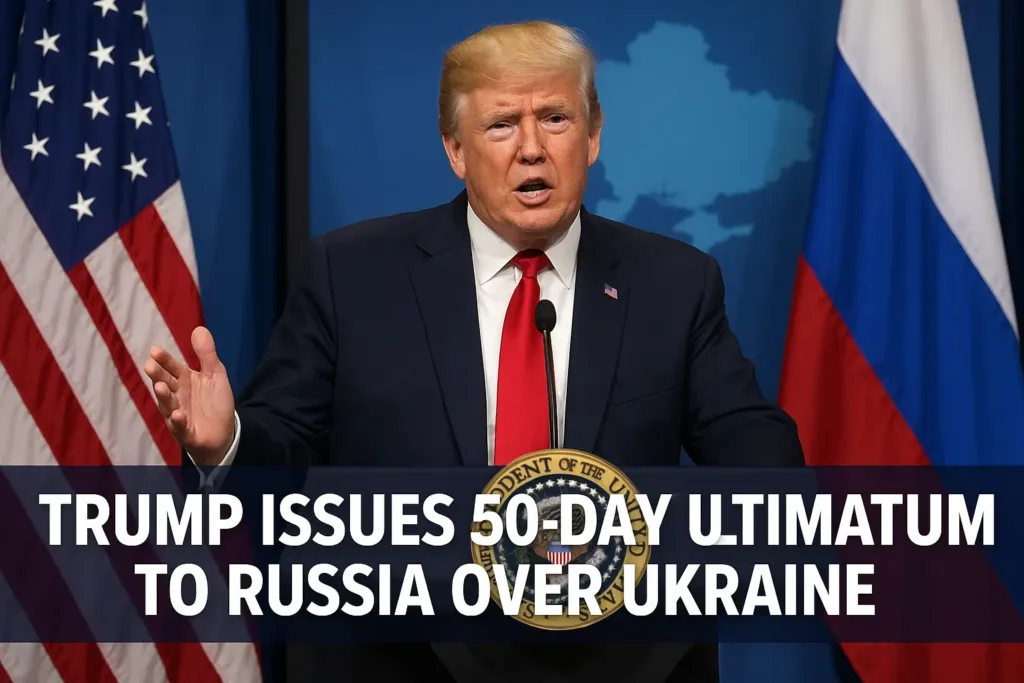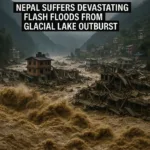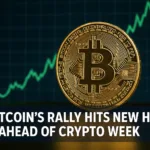
📅 July 15, 2025 | Washington D.C. – In a bold diplomatic move, 🇺🇸 U.S. President Donald Trump has issued a 50-day ultimatum to the 🇷🇺 Russian government, urging it to pursue peace talks with 🇺🇦 Ukraine or face renewed and intensified economic pressure from the United States and its allies.
The announcement, delivered from the 🎙️ White House press briefing room, marks one of the most direct deadlines Washington has set since Russia’s 2022 invasion of Ukraine. The ultimatum comes at a time when the conflict has entered a stalemate, with intermittent fighting, civilian casualties, and no long-term resolution in sight.
⚠️ The Ultimatum: What It Means
President Trump’s 50-day timeline is essentially a 🕰️ diplomatic countdown:
✅ If Russia agrees to enter “good-faith” peace negotiations within 50 days, the U.S. may suspend or roll back certain pending sanctions.
❌ If Russia ignores the demand or escalates the war, Washington has vowed to impose a new wave of financial 💵, energy ⚡, and technology 💻 sanctions that could severely impact Russia’s economy and global partnerships.
In addition, Trump warned of “secondary sanctions” targeting third-party nations or companies doing business with sanctioned Russian entities—🎯 a clear signal to China 🇨🇳, India 🇮🇳, and Brazil 🇧🇷.
🇺🇸 Why Now?
President Trump’s move follows growing frustration within NATO and U.S. circles about the prolonged conflict in Ukraine. While U.S. military aid continues to flow, 🏛️ political pressure is mounting at home to either force a resolution or redefine America’s commitment.
🧩 Several key developments led to this action:
🪖 Stalemate in Eastern Ukraine: Russian forces remain entrenched in the Donbas and Crimea, with little progress toward diplomacy.
💰 Rising cost of war: U.S. and European taxpayers are questioning long-term funding for Ukraine’s defence.
🧭 NATO Summit momentum: The ultimatum follows the 2025 NATO Summit in The Hague, where members pledged to increase defence spending to 5% of GDP—a sign of growing regional concern.
📦 What’s at Stake for Russia?
If Russia ignores the deadline, the consequences could be serious:
💣 Expanded Sanctions: New measures would target Russian state banks🏦, energy exports⛽, and military supply chains⚙️.
🛢️ Oil & Gas Isolation: The U.S. and EU may block Russian access to key energy markets like India and China.
🧊 Diplomatic Freeze: Russia could face deepening isolation from the UN 🇺🇳, G20 🌐, and other forums.
🛡️ Military Support for Ukraine: The U.S. has committed to more military aid, including Patriot missile systems 🎯, with more possibly on the way.
🇷🇺 Russia’s Response So Far
The Kremlin has condemned the ultimatum, calling it “imperialist blackmail” and accusing the U.S. of undermining peace efforts.
🗣️ Russian Foreign Minister Sergei Lavrov stated that “Russia will not negotiate under threats” and dismissed the 50-day timeline as a “non-starter for diplomacy.”
Despite this, analysts believe that growing economic pressure 📉 and civil unrest 👥 may eventually push Moscow to reconsider.
🕊️ Is Peace Possible?
While Trump’s ultimatum adds urgency, many experts question whether genuine talks can be launched so quickly.
🇺🇦 Ukraine’s stance: President Volodymyr Zelenskyy insists that Russia must withdraw from occupied territory before talks can begin.
🌍 International mediators: Turkey 🇹🇷, India 🇮🇳, and Switzerland 🇨🇭 have offered to host peace talks, but finding neutral ground and acceptable terms remains challenging.
🔥 Risk of escalation: Some fear the deadline could backfire, provoking further military aggression instead of peace.
🧠 Strategic Analysis
Trump’s strategy signals a shift from traditional diplomacy to deadline-driven geopolitics⏳. By setting a clear timetable, the U.S. is applying pressure to force a decision—peace or further confrontation.
🔍 The outcome depends on:
🇷🇺 Russia’s internal politics
🇮🇳🇨🇳 China and India’s response to secondary sanctions
🇺🇦 Ukraine’s flexibility in negotiations
🤝 NATO–EU unity and enforcement


